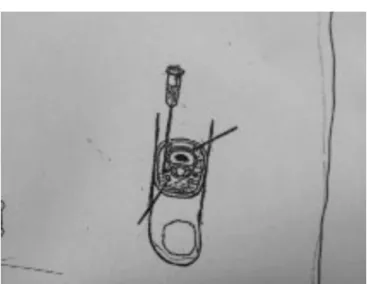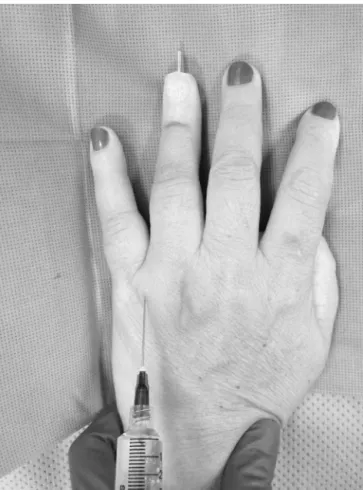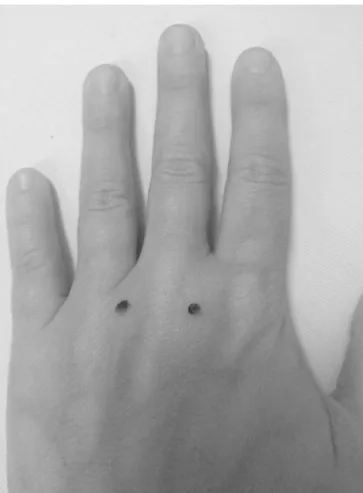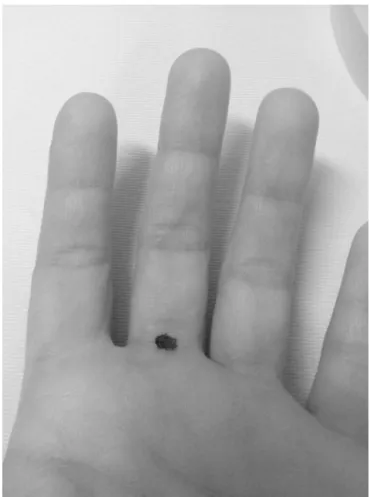REVISTA
BRASILEIRA
DE
ANESTESIOLOGIA
OfficialPublicationoftheBrazilianSocietyofAnesthesiologywww.sba.com.br
REVIEW
ARTICLE
Digital
block
with
or
without
the
addition
of
epinephrine
in
the
anesthetic
solution
Almiro
dos
Reis
Júnior
a,b,c,∗,
Denise
Quinto
a,baServic¸oMédicodeAnestesia(SMA),SãoPaulo,SP,Brazil
bHospitalAlemãoOswaldoCruz,SãoPaulo,SP,Brazil
cSociedadedeAnestesiologiadoEstadodeSãoPaulo(Saesp),SãoPaulo,SP,Brazil
Received27October2013;accepted3December2013 Availableonline25November2015
KEYWORDS Anesthesia,regional; Localanesthetics, cocaine,lidocaine, bupivacaine, ropivacaine; Surgery,fingers; Ischemia, epinephrine
Abstract
Backgroundandobjectives: Review ofvarious techniquesfor digital blocks with local anes-thetic,withorwithoutepinephrine.
Contents:Description ofvarious procedures andcomparison of results reported inthe lit-erature, mainly on latency and quality of anesthesia, details on vasoconstrictor effect of epinephrine,intraoperativebleeding,necessityoftourniquetuse,durationofanesthesiaand postoperativeanalgesia,bloodflowanddigitalSpO2behavior,localandsystemiccomplications,
andalsoapproachesanddrugstobeusedincertainsituationsofischemia.
Conclusions: Theadvantagesofaddingepinephrinetotheanestheticsolutionareminorwhen comparedtotherisksoftheprocedure,anditseemsdangeroustouseavasoconstrictorinthe fingers,unlessthesafetyofthetechniqueandthepossibilityofdiscardingthetourniquetare definitelyproven.
© 2014SociedadeBrasileirade Anestesiologia.Publishedby ElsevierEditoraLtda.Allrights reserved.
PALAVRAS-CHAVE Anestesia,regional; Anestésicoslocais, cocaína,lidocaína, bupivacaína, ropivacaína;
Bloqueiosemdedosdemãoscomepinefrinaincluídaounãonassoluc¸õesanestésicas
Resumo
Justificativaeobjetivos: Revisãodasdiversastécnicasparabloqueiosemdedosdemãos,com anestésicolocalassociadoounãoàepinefrina.
Conteúdo: Sãodescritososprocedimentosusadosecomparadososresultadosobtidosna liter-atura,principalmenteemrelac¸ãoa:latênciaequalidadedaanestesia,detalhessobreoefeito vasoconstritordaepinefrina,sangramentointraoperatório,necessidadeounãodousode torni-quete,durac¸ãodaanestesiaedaanalgesiapós-operatórias,comportamentodofluxoarteriale
∗Correspondingauthor.
E-mail:almiroreisjr@uol.com.br(A.ReisJúnior).
http://dx.doi.org/10.1016/j.bjane.2013.12.004
Blockadesare used in fingers for smallsurgical interven-tions,withorwithout theuseofdigital tourniquets,since theuseofgeneralanesthesiaforsuchsurgicalproceduresis ofgreaterrisks,unnecessarymostofthetimeandfarmore expensive.However,duetothepossibilityofserious conse-quences,digitalanesthetic blocks,particularlythosewith theuse of tourniquet,should be done carefully and with goodknowledgeoftheregionalanatomyandits contraindi-cations.
Thelatestnationaltreatiesofanesthesiologyassessthe subjectinanextremelysimplifiedform.Soitseemstobethe timetoupdateit,asitisofinterestnotonlytoorthopedic surgeons,hand surgeons, and dermatologistsspecialize in nail disease processes,but alsofor anesthesiologists who shouldbeawareofthesesubjectsastheymaybeinvolvedin casesofcomplicationsforhavingperformedsuchanesthetic actsorjusttakenpartinthesurgery.
Digitalanestheticblocksconsist fundamentallyoflocal anestheticdepositioninthevicinityofnerves;tothisend, first,majorregionalanatomicaldetailsshouldbewellknown (Fig.1). The dorsal digital nerves derive from the radial andulnar nerves, pass throughthe dorsolateralregion of thefingers,andinnervatealmostallregionsoffingerstoits proximaljoints,asthedistalregionsoftheindex,middle, andpartof thering fingersareinnervatedby themedian nerve.1---3 The median andulnarnerves giverisetodigital nervesthatsupplymostofthepalmar,adjacentside,ends offingers,andnail bedregions; theyareaccompaniedby bloodvesselsandpassthroughtheventrolateralregionsof thefingersandthesideoftheflexortendonsheaths.
Techniques
for
digital
anesthetic
blocks
First,onemustknow thecontraindicationsfor performing theseanestheticblockades.Theseareasfollows:absolute, suchaspatient’srefusaltoundergotheprocedure, periph-eralvascular disease in the region, andinfection next to theinjectionsite.Relative,whenitisabsolutelynecessary totestnervefunctionearlyinthepostoperativeperioddue toblockadeestablishmentofsensoryandmotorconduction wheneverthis condition can mask the establishment of a postoperative compartment syndrome. And in a patient already with nerve damage or paresthesia, due to the alwayspresent possibilityofcausingnerveinjury.1---4There
Figure 1 Crosssection ofthe baseof proximalphalanx of finger.Notethepositioningofdorsal(rightarrow)andventral (leftarrow)digitalnervesandvessels.Alsonotetheneedlefor thesenervesblockadebydorsolateralrouteoffingerbase. ModifiedfromFigures10---17(A)byRef.1.
areseveral techniques withminormodifications thatvary fromauthortoauthor.1---3,5---9
Figure 2 Subcutaneous blockade ofthe dorsal and palmar nervesofrightindexfinger.Illustration:GladysN.dosReis.
with the same characteristics mentioned above; 1mL of anesthetic solution is injected superficially to block the dorsaldigitalnerveandtheneedleisadvancedtoblockthe palmardigitalnerve.This proceduremustberepeatedon theothersideaftertheneedlehasbeenwithdrawntothe skinandredirectedtotheoppositesideofthefinger back tosuperficiallyapplyanother1mLofanestheticsolution.2 Caremustalwaysbeexercisedwiththeanestheticsolution volumesadministeredinordernottocreateacompression circumferentialringofneurovascularbundles.
Thetransmetacarpaltechnique1,3fordigitalnerveblock is performed withfingers extended, by thedorsal sideof thehand, thinnerthanthe palmar,approximatelyat 1cm of metacarpophalangeal joints and half-way between the metacarpalbones(Fig.3).Thetechniqueinvolvesthe intro-duction and advancement of the needle until the palmar aponeurosis resistance is perceived, and then 2---3mL of anestheticsolutionwithoutepinephrineshouldbeinjected as the needle is slowly withdrawn. The same procedure is done on the other side of the finger. The procedure can bedone by the palmside of the hand and,similarly, 2---3mLanestheticsolutionmustbeinjectedjustbehindthe metacarpalheads,whichfullyanesthetizesthecommon dig-italnervethatsuppliesthefinger,which,however,itisless comfortableforthepatient,duetotheskinthicknessinthis region,asnotedabove.Aninterestingdetailwasproposed tofacilitatethetransmetacarpaltechniqueinduction,3 con-sisting of holding the patient’s hand by the fingers with the non-dominant hand of the operator and marking two pointsoneachsideofthemetacarpophalangealjoints;the patient’shandisthenextendedandthetwomarksindicate the needle entrypoints (Fig.4). The main advantages of thelattertechniqueare:thepuncturesaremadewiththe patient’shandinapositionwhichhelpstostabilizeit,the points for injections are more accurate and easily deter-mined, therisk of neurovascularlesion is smaller andit’s easierforthedigitalblocktobetaught.3
Thetransthecalmethodwasdescribedin1990whenthe quick installationof anesthesiathroughout the finger was seenaftertheapplicationofasteroidandlidocainemixture tothe flexortendon sheathfor trigger finger treatment.5
Figure3 Blockadeofringfingerbytransmetacarpal route. Needleinsertionisthroughthedorsalsideofthehand,about 1cmfrommetacarpophalangealjointandhalfwaybetweentwo metacarpalbones.Detailsinthetext. Photocourtesy ofthe handsurgeonDr.NiveaGitahyRizzi.
Sincethen,thistendonsheathispuncturedforanesthetic solutionadministration at the level of the palmar digital crease;theneedleshouldpenetratethistendonsheathupto bonecontactisfelt2,3,5,8,9(Fig.5).Then,theneedleshould beslowlyremoveduntiltheanestheticsolution(about2mL) iseasily administered intothe spacebetween the perios-teumandflexortendon.Astheanestheticisapplied,there is a local turgidity and slight flexion of the finger. This method’s advantages include single injection, no risk of directmechanicaltraumaoftheneurovascularbundle,and rapid deployment of anesthesia. However, the procedure includes risks such as tendon injury and potential infec-tioninaclosedspacebecauseitviolatestheflexorsynovial sheath2,3;besides, comparisonbetween subcutaneousand transthecalblocksusedin162volunteersshowedthatthe latteranestheticmethodproducesmorepainduring injec-tion,adiscomfortthatpersistsforupto24h.6
Figure4 Transmetacarpalblockadewithoutstretchedhand. Thereferencepointsweremarkedtofacilitatetheanesthetic solutionapplication.Detailsinthetext.
injection with epinephrine. The anesthesia lasted 48min whenepinephrinewasnotusedand280minwhenthe vaso-constrictor wasused. Withthe highest concentrationand doseof lidocaine(2%5.4mL)withepinephrine1:100,000, anesthesiacanlastuptotwicethattime.10
One option to digital blocks is the use of intravenous regionalanesthesia,11 which,whenusedinafinger,hasno truncal but only infiltrative action (Fig. 7). It is induced afterpuncturingthevein onfinger dorsum,almostalways easywith27Gneedleorbutterflyneedleofsimilargauge, exsanguinationbyrubbingthefingerinthedistal-proximal directionwiththeoperator’sindexfingercircularlyaround it,withdelicateelasticbandorevenjustbygravity,rapid applicationoftourniquetinitsroot,securewithhemostat clamp,andadministrationof2---3mL,accordingtothe fin-ger size, of any local anesthetic currently in use, always withoutepinephrine;anesthesiaisimmediatelyestablished. Thegreatadvantageofthisanestheticmethodistoavoid totallythepossibilityofdigitalneurovascularbundleinjury. Thedisadvantagesofintravenousregionalanesthesiafor fin-gersaretheshortdurationof postoperativeanalgesiaand tourniquetpain(required)afterprolongeduse,whichcanbe avoidedbyapplyingasecondtourniquetslightlymoredistal andanestheticfollowedby deactivationofthetourniquet previouslyinstalled.11Itisworthnotingthatinthe1980sa comprehensivetechnologywascreatedfortheprocedure.12 Whereseveralfingersareinvolvedinthesurgery,agood optionisablockadeatthewristlevel.1
Figure5 Transthecalblockade.Thepunctureforanesthetic solutionadministrationisperformedinthesheathofthefinger flexortendon(proximallevelofthepalmardigitalcreaseora littlemoredistal).PhotocourtesyofthehandsurgeonDr.Nivea GitahyRizzi.
Figure6 Locationforhandfingerblockusingonlyonelocal anestheticinjectioninto thesubcutaneousspaceandapplied approximatelyatthelevelofthemidpointofpalmarinterdigital crease.
Addition
of
epinephrine
to
anesthetic
solution
Ithasalwaysbeennotoriousamongus,andstillis,the con-ductnotusingepinephrineassociatedwithlocalanesthetic forsurgicalproceduresonfingersduetothepotentialriskof irreversiblevascularspasm.However,ithasbeenstatedthat
Figure 7 Digital intravenous regional anesthesia. Note the tubularrubbertourniquetkeptbyhemostatclampandthe anes-theticbeingadministeredindorsalveinofmiddlefinger. ReproducedfromRef.11.Withpermissionofthepublisher.
‘‘manydoctorsbelieveitbecauseitwaswhattheylearned inmedicalschoolsworldwide’’.
The main anesthesiology treaties and numerous arti-clespublisheduntil recentlydonotadmit theadditionof epinephrinetoanestheticsolutionsforsuchsurgeries;itis alsopronouncedin dermatology,plasticsurgery, andhand surgerytexts,1,2,11,12despite,accordingtosome,thelackof validevidencein theliterature aboutthis concept.13 It is well knownthat this association is muchmore dangerous in patients with conditions that could impair finger per-fusion,suchaspheochromocytoma,hyperthyroidism,severe hypertension,heartdiseaseorRaynaud’sphenomenon, scle-rodactyly,andtelangiectasia.14---17Itistruethatthefingers havegreatabilitytoresistischemicinsultsbecauseoftheir structure,which hasskin, bones,tendons, andligaments, butnotstriated muscles, whicharevery sensitive tolack ofoxygen,14,18andthatepinephrineactionsareshort-lived whenusedatverydilutedsolutions.18,19
Thereviewofthehistoryoftheuseoflocalanesthetic associated with epinephrine shows that it never lost its dangerous reputation, which began more than a century ago.1,18,20Isolatedfromtheadrenalglandincrystallineform byAbelin1897,initiallynamedTakamina,epinephrinewas patentedin1901asAdrenaline.In1903,Braun,creatorof the term conduction anesthesia, inspired by Corning and Halsted ideas, popularized the additionof epinephrine in smallquantitiestococaine solutions, theonly local anes-theticavailableuntiltheintroductionofprocainebyEinhorn in1904,andcreatedwhathecalledchemicaltourniquet,in ordertoslowtheabsorptionofthelocalanestheticand pro-longitsaction.But,asavasoconstrictor,cocaineproduced thefirstgangreneasadigitalblockcomplication,whichwas followedbyseveralotherovertheyears,apparently exclu-sivelyinvolvingepinephrine.1,13,18Braunhadalreadywarned thatthe vasoconstrictoraction was veryintense and pro-longedthatcouldcausethiscomplication,especiallywhen the nutrition in the region is already impaired. About it, somebelievethatinthepastepinephrinewasimperfectly dilutedin anesthetics, and differently fromhowthey are preparedtoday18 or that the procainewasused afterthe expirationdate, acidified and toxic,and thus contributed tothedigitalnecrosisattributedtoepinephrine.21,22Thus, thediscussionabouttheuseofepinephrineindigital anes-thetic block is not new; for example, in 1933 it was used(1:100,000) in more than 1500 patients, a period in whichseveralcasesoffingergangreneweredescribedwith andwithoutthevasoconstrictoradditiontotheanesthetic solutions.18 Other agents, such asphenylephrine and nor-epinephrine,areineffectiveregardingtheeffectsachieved withepinephrine.13,23
lowdosesofepinephrine,suchas1:100,000.
In recent years, numerous studies sought to compare digitalblockswith localanesthetics withandwithout the addition of epinephrine, including volunteers, in order to obtain favorable or unfavorable information of this technique versus the classical, which does not include epinephrine,suchaslatency,qualityanddurationof anes-thesia, epinephrineconcentrations in anesthetic solutions that can be considered correct, important risk of finger ischemia,intraoperativebleeding,needfortourniquetuse, requirementornotofadditionalanesthesia,postoperative analgesiatime,andtreatment ofcomplications.15,18,24,27,28 Someofthesestudiesarelistedbelow.
In 2010, 1111 anesthetic blocks were performed in patients aged 6 months to 93 years, undergoing finger surgeries,using onlythe dorsal blockade or the transthe-caltechniqueandtourniquet29;611subjectswhoreceived lidocainewithoutepinephrine(5.7mLaverage)were com-paredwith500subjectsreceivinglidocainewithepinephrine 1:100,000 (4.33mL average) and none of them suffered finger loss resulting from the use of this type of anes-thetic solution; besides, there was no need for drug treatment.
A prospective non-randomized study, for justified rea-sons, performed between 2002 and 2004, evaluated3110 surgicalprocedures in hands(1270) or fingers(1340) with anesthetic blocks administered with lidocaine or bupiva-caine and epinephrine, usually 1:100,000, and there was nolossofdigitaltissue.15Ithasbeensuggestedthatifthe casesin this study are added tothe study cited aboveit wouldsumup4221patients(actually,2451,astherestwere notproperlyonfingers),alargenumberofresultswouldbe obtainedenoughtodenythetraditionaldogmaagainstthe useof epinephrinein fingers. Medicationtoreverse vaso-constriction probablywasnotusedonthe groundsthatif theischemiceventsweresignificant,theauthorsprobably wouldhaveusedit,buthavenotregisteredtheirconduct.18 Astudy carriedoutin 2005revealed thatthe vasocon-strictiveeffectofepinephrine(1:100,000)disappearsinjust over6h, thefinger isoccasionally bluish,especiallywhen tourniquetis used,thecolor ofthatfingerbecomesequal tothecolorofthenon-injectedfingersofthesamehand. Moreover,evenwhenepinephrinewasadministerednearthe neurovascularbundlesitissometimespossibletoseeblood pulsingin the vesselsbathed inthe anestheticsolution,15 whichsupportsresearchinwhichthedigitalarterialblood
were4.1forGroupAand1.4forGroupB;(4)intraoperative bleedingsignificantlymoreimportantinGroupA(20%)and itwasnecessarytousetourniquetorothermeasures;(5)the durationofpostoperativeanalgesiawas2.4hforpatientsin GroupAand4.6hforGroupB;and(6)onepatientineach grouphadhypertensivecrisis.
A study of 100 patients (106 digital blocks),19 aged 15---83 years,whoreceivedanesthetic solutionof 2% lido-caine(2mL)withepinephrine(1:80,000)infiltratedaround each digital nerve and dorsum of the proximal phalanx (0.5mL),alwayswiththeuseofdentalsyringeandneedle 27,reportedcompleteanesthesiaandapalecircumferential zonearoundthebaseofeachfingerblocked,certainlydue tovasoconstriction.Specificallyonfingerarterialbloodflow afterblockingwithlidocaine-epinephrine,itwasnotedin10 patients thatitdeclined rapidlywithinthefirst5---10min, increasedgradually,andreturnedtonormalwithin60min, thatbleedinginsurgical woundswerenormalandthe fin-gers become clinically well-perfused after every surgical intervention.Itwasalsoobservedthatfortheperiods imme-diatelyprecedingtheanestheticblockinstallationthemean systolicblood pressureswerelittlereduced, andthe digi-talextremitytemperaturesexperiencednegligibleincreases whenmeasuredaftertheoccurrenceofreactivehyperemia. Astudy onblood gas parametersmeasured beforeand 15min after digital blocks with lidocaine solutions with or without epinephrine reported that the SpO2 slightly increasedaftertheanestheticblocksand,soonafter,ithad smallreductions,buttherewerenosignificantdifferences betweenthetwogroups.28
fingersbecomeredinlesstimethanwiththeusual extravas-cularinjection.Itis possiblethatthe shortestdurationof thisvasoconstrictionmayberelatedtotheverylowhalf-life ofplasmaepinephrine.15
Indeed,thereareoftendoubtsaboutthetruecausesof injuriesmakingitdifficulttodiagnoseitamongmany possi-bilities,suchasthepresenceofperipheralvasculardisease, excessiveamountsofanestheticsolutioninconfinedspaces, highmechanicalpressuremotivatedbyanestheticblockat the finger base, vascular injury caused by needle, burns, infections,andpoorlymaintaineddressings.Allinaddition tothehighpressurecausedbyverytighttourniquetsofsmall widthorforlongtime,andnon-compliancewiththe recom-mendationsforanestheticblockinfingerswiththeaddition ofepinephrineintheanestheticsolution,althoughitcannot besaidthatdigitalischemiadoesnotoccurwiththeuseof lowerdosesofepinephrine.1,14,15,18,23
However, as a demonstration of the ischemia severity that can be caused by epinephrine when injected alone and/or accidentally on the finger, there is a consider-ablenumberofpublications.Intheliterature(1900---2005), therearerecordsof59patientsinwhomlocalanesthetics wereadministeredwithepinephrineinhigh concentration (1:1000);ofthese,32receivednotreatment, andnoneof themsuffereddigitalnecrosis,buthadpainforfourhours andneuropraxisfor10weeks.21Manyofthesecomplications involvedequipment(EpiPen)containingepinephrineinhigh concentration(1:1000),most commonly usedby dermato-logists,allergists,andradiologistsfortreatmentofallergic emergencies.21,32---40 The injected doses variedwidely and the main symptoms were pain (86%), pallor (53%), and, toalesserpercentage,numbness,bruising,ischemia,and decreasedcapillaryrefill,whichlastedfor2honaverage; no drugs were used in 77% of affected patients, but the remainingpatientsreceivedglycerinpaste,phentolamine, nitroglycerine plus phentolamine or terbutaline.30,33 Cal-ciumchannelblockersandtopicglyceroltrinitratehavealso beenused,buthaveoftenprovedineffective.34
Thefollowingdescribesonlytwoofthenumerous situa-tionsthathaveoccurredwithsuchequipment(EpiPen).An X-raytechniquesufferedaccidentalinjectionofepinephrine inthumbpulpwhenhandlingabsentlythedevice(EpiPen), resulting in pallor, cold, and numbness in the affected area.35Theclinicalsituationhasnotimprovedwithanhour of heating so phentolamine and calcium channel blocker wereusedtocombatthevasospasmeffects.Phentolamine (5mg) diluted in saline solution (9mL) was administered in the thumb pulp and over the digital artery (total: 4mL=3.5mg)andcalciumblocker(90mg)wasusedorally; therewasimmediateheatingofthethumb.Thepatientwas observedfor twohours,duringwhich thefinger remained warm and rosy, and then she was discharged. Another accident, similar to the above, occurred with a nurse whohandledincorrectlythesameequipment(EpiPen)and injectedepinephrine(1:1000)inthethumbofateammate whowaspresentingwithanaphylacticreactionbyingested food.34 The thumbimmediately becamepale andwithout sensitivityandmotor function.She wastreated with stel-late ganglion block and herthumb became well perfused andnormalwithinhours.
As in the above two cases, whenever high doses of epinephrine are used, it is necessary to take immediate
measures toprevent irreversible digital ischemia,18,21,32,34 and the administration of phentolamine 1mg diluted in saline solution 1mL is recommended.21 However, many treatvasoconstrictiononlywithheatandobservation,and drug treatment (usually phentolamine) is initiated only if symptoms do not improve in two hours.30 The use of phentolamine began only in 1957 and currently it is the mostcommonly used drug,withgreat success incases of majorvasoconstrictions.21Itisanalpha-blockerintroduced tocombat effectscausedby catecholamines;itshouldbe administered in the same place where epinephrine was injected and may be used up to 13h after the incident; digital vasoconstriction is consistently reversed in about 85---90min.14,15,21 It is good toknow, however, that phen-tolamine used at doses ranging from 1.0 to 3.5mg may triggersideeffects,suchascardiacarrhythmiaandsevere hypotension.
Because it is an undisputed fact that the use of epinephrinehasdanger,besidesthemainprecautions men-tionedabove,severaladditionalprecautions arecarefully and proactively recommended by the supporters of dig-ital blocks with local anesthetics associated with the vasoconstrictor13---19,24:(1)selectwellthepatientswhowill receive epinephrine; (2) avoid it in young children, peo-plewithpheochromocytoma, heart or peripheral vascular disease, in poor clinical condition or in other situations previously mentioned; (3) 1% or 2% lidocaine should be preferredbecause,asasmoothmusclerelaxantand vaso-constrictor, it is supposed to decrease temporarily the vasoconstrictor action of epinephrine and, thus, presum-ablyprotectthe digital blood flow; (4)use solutions with epinephrine1:200,000,although1:100,000seemssafetobe used,butnever1:80,000orlessdiluted;(5)usesmall vol-umesofanesthetics,asmuchaspossible;(6)ifacommercial preparationoflidocaineandepinephrineatlowpH(3.5)is used,itshouldbebufferedwithsodiumbicarbonate(8.4%) at 1:10 ratioto prevent local acidosis; (7) keep patients underobservation untilthe returnof normal color tothe finger, especially in cases of prolonged ischemia, which mayrequirereversalwithnitroglycerinointment,inminor cases,or with injections of 2.5mg phentolamine----haveit athand----dilutedwithsaline(4.5to9.0mL);(8)donotuse epinephrinewithout perfectknowledge of howtoreverse itspossiblevasoconstriction,whichwouldbesimilartousing morphinewithoutunderstandingthemechanismofactionof naloxone;and(9)discloseindetailwhenfacinganydigital blockcomplication.
With the observance of all care described above, the combination of lidocaine-epinephrine would have some advantages13---19,23,24,29: (1) shorter latency of anesthesia, which is discussed; (2) use of lower doses of local anes-thetics,thus reducing itssystemictoxicity;(3)temporary reductionoflocalbloodflow and,thus, ofbleedinginthe surgical area; (4) prolongation of anesthesia and analge-siapostoperatively;and(5)greatpossibilityofwaivingthe tourniquet,whichlowerstheraceagainsttheclockandthe risksfromdigitaltourniquet.
Final
considerations
lyzed:(1)anestheticsolutionwithepinephrineshouldnot beadministeredinpediatricpatients;(2)thedifferencein thelatencydurationofanesthesiawhenepinephrineisused ornotisoflittleimportance;(3)theconceptofusingthe lowest possible dose of local anesthetic is valid for solu-tionsbothwithandwithoutepinephrine;(4)thereduction of systemiclocal anesthetic toxicityis negligible because thedosescommonlyusedareextremelylowandoffer vir-tuallynoriskofcomplications,exceptforthepresenceof epinephrineinthesolutions;(5)administrationofadditional dosesoflocalanestheticswithoutepinephrineisalsorarely necessary;(6)bupivacaineandropivacaine,thelatterwith smallvasoconstriction,have longer effects than lidocaine andsufficientforalmostalldigitalsurgicalprocedures;(7) ascommercial preparations of lidocainewithepinephrine are almost always used, more laborious precautions are oftennecessarytopreventlocalacidosis;(8)theduration ofanesthesiawithepinephrine,whichislongerthanwithout epinephrine,is onlyimportantinverylongsurgical proce-dures;(9)itisnecessarytomonitorthepatientforalonger timewhenepinephrineisaddedtotheanestheticsolution becauseitsvasoconstrictionmayrequiretheuseofdrugs, particularlyphentolamine;and(10)thetourniquet undoubt-edly provides a much drier surgical field, avoids waiting untilepinephrinereachesitsfullvasoconstrictoraction,it’s alwayswelltoleratedaslong astheskinintheareaofits application is anesthetized, and helpsto keep the finger insensitive,althoughitcantrulycausecomplicationswhen misapplied.
Thus,consideringalloftheabove,whilethereis abso-lutelynoconcrete anddefinitiveevidence ofthe absence of danger with the addition of epinephrine to the anes-theticsolutionandsignificantadvantages ofthisapproach todigitalblocks,itsusedoesnotseemprudentordecisively fruitfulinsuchanestheticprocedures.
Conflicts
of
interest
Theauthorsdeclarenoconflictsofinterest.
References
1.BridenbaughLD.Theupper extremity:somaticblockade. In: CousinsMJ,BridenbaughPO,editors.Neuralblockadeinclinical
dorsal block for digital anesthesia. Plast Reconstr Surg. 2000;118:1195---200.
8.CummingsAJ,TisolW, MeyerLE.Modifiedtransthecaldigital blockversustraditionaldigitalblockforanesthesiaofthefinger. JHandSurg.2004;29:44---8.
9.Sonohata A, AsamiK, OgawaS, et al. Single injection digi-talblock:is a transthecalinjectionnecessary? J HandSurg. 2009;34:94---8.
10.Sonohata M, Nagamine S, Maeda K, et al. Subcuta-neous single injection digital block with epinephrine. Anes-thesiology Research Practice. 2012:4, http://dx.doi.org/ 10.1155/2012/487650.AN487650.
11.ReisAJr.Anestesiaregionalintravenosa.1sted.RiodeJaneiro: EditoraAtheneu;1996.p.203---7.
12.ReisJA.Cartaaoeditor:Anestesiaregionalintravenosadigital. RevBrasAnestesiol.1990;40:77.
13.Wilhelmi BJ, Blackwell SJ, Miller JH, et al. Do not use epinephrineindigitalblocks:mythortruth?PlastReconstrSurg. 2001;107:393---7.
14.KrunicAL,Wang LC,SoltaniK,etal. Digitalanesthesiawith epinephrine: an old myth revisited. J Am Acad Dermatol. 2004;51:755---9.
15.LalondeDH,BellM,BenoitP,etal.Amulticenterprospective studyof3,110 consecutivecases ofelectiveepinephrineuse inthefingersandhand:theDalhousieprojectclinicalphase.J HandSurg(Am).2005;30:1061---7.
16.ChowdhryS, Seidenstricker L, CooneyDS, et al. Do notuse epinephrineindigital blocks:mythor truth.Aretrospective reviewof1,111cases.PlastReconstrSurg.2010;126:2031---4.
17.MannT, HammertWC.Epinephrineandhandsurgery.JHand Surg.2012;37:1254---6.
18.DenklerK.Acomprehensivereviewofepinephrineinthefinger: todoornottodo.PlastReconstrSurg.2001;108:114---24.
19.SylaidisP,LoganA.Digitalblockswithadrenaline.Anolddogma refuted.JHandSurg.1998;23:17---9.
20.Denkler KA. Epinephrine in the digits. Plast Reconstr Surg. 2011;128:598.
21.Fizcharles-Bowe C, Denkler KA, Lalonde DH. Hand. 2007;2:5---11.
22.ThomsonCJ,LalondeDH,DenklerKA,etal.Acriticallookat theevidenceforand againstelectiveepinephrineuseinthe finger.PlastReconstrSurg.2007;119:260---6.
23.WilhelmiBJ,BlackwellSJ,MillerJH,etal.Epinephrineindigital blocks:revisited.AnnPlastSurg.1998;41:410---4.
24.Andrades PR, Olguin FA. Digital blocks with or without epinephrine.PlastReconstrSurg.2003;111:1769---70.
26.DenklerK. Dupuytren’sfaciectomies in60consecutive digits using lidocaine with epinephrine and no tourniquete. Plast ReconstrSurg.2005;115:802---10.
27.WaterbrookAL,GermanCA,SouthallJC.Isepinephrine harm-fulwhenusedwithanestheticsfordigitalnerveblockers?Ann EmergMed.2007;50:472---5.
28.SönmezA, YamanM, EsroyB, et al. Digitalblocks withand withoutadrenaline:arandomized-controlledstudyofcapillary bloodparameters.JHandSurg.2008;33:515---8.
29.LalondeDH,LalondJF. Discussion:donotuseepinephrinein digitalblocks:mythortruth?ParII.Aretrospectivereviewof 1111cases.PlastReconstrSurg.2010;126:2035---6.
30.MuckAE,BebartaVS,BorysDJ,etal.Sixyearsofepinephrine digital injections: absence of significant local or systemic effects.AnnEmergMed.2010;56:270---5.
31.Altinyazar HC, Ozdemir H, Koca R, et al. Epinephrine in digital block: color Doppler flow imaging. Dermatol Surg. 2004;30:508---11.
32.McGovern SJ. Treatment of accidental injection of adrenaline from an auto-injector-device. J Accid Emerg Med.1997;14:379---80.
33.LeeG, ThomasPC.Accidentaldigital injectionofadrenaline fromanautoinjectordevice.JAccidEmergMed.1998;15:287.
34.Barkhordarian AR, Wakelin SH, Paes TRF. Accidental digital injectionofadrenalinefromanautoinjectordevice.BrJ Der-matol.2000;43:359.
35.Kairalla E. Epinephrine-induced digital ischemia relieved by phentolamine.PlastReconstrSurg.2001;108:1831---2.
36.VelissariouI,CotrellS,BerryK,etal.Managementofadrenaline (epinephrine)induceddigitalischemiainchildrenafter acci-dentalinjectionfromanEpiPen.EmergMedJ.2004;21:387---8.
37.SchintlerMV, ArbabE, AbererW, et al.Accidental perforat-ingboneinjuryusingtheEpiPenautoinjectiondevice.Allergy. 2005;60:259---60.
38.SichererSH,SimonsFE.Self-injectableepinephrineforfirst-aid managementofanaphylaxis.Pediatrics.2007;119:638---46.
39.MathezC,FavratB,StaegerP.Managementoptionsfor acciden-talinjectionofepinephrinefromanautoinjector:acasereport. JMedCaseReports.2009;3:7268.



